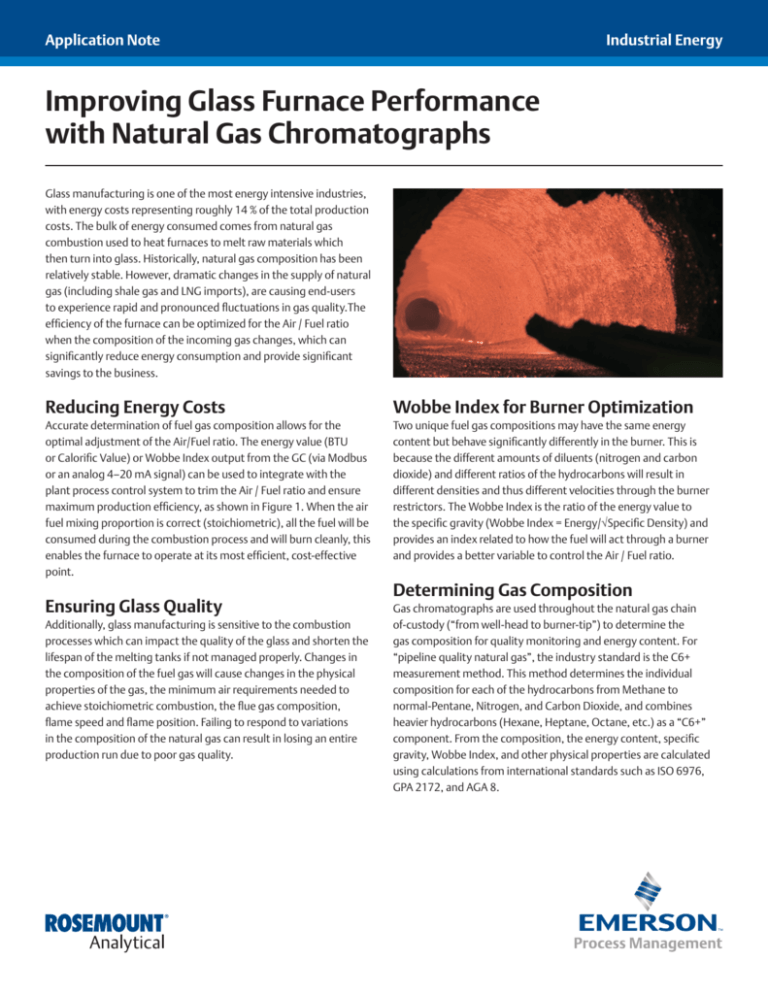
Application Note
Industrial Energy
Improving Glass Furnace Performance
with Natural Gas Chromatographs
Glass manufacturing is one of the most energy intensive industries,
with energy costs representing roughly 14 % of the total production
costs. The bulk of energy consumed comes from natural gas
combustion used to heat furnaces to melt raw materials which
then turn into glass. Historically, natural gas composition has been
relatively stable. However, dramatic changes in the supply of natural
gas (including shale gas and LNG imports), are causing end-users
to experience rapid and pronounced fluctuations in gas quality.The
efficiency of the furnace can be optimized for the Air / Fuel ratio
when the composition of the incoming gas changes, which can
significantly reduce energy consumption and provide significant
savings to the business.
Reducing Energy Costs
Wobbe Index for Burner Optimization
Accurate determination of fuel gas composition allows for the
optimal adjustment of the Air/Fuel ratio. The energy value (BTU
or Calorific Value) or Wobbe Index output from the GC (via Modbus
or an analog 4–20 mA signal) can be used to integrate with the
plant process control system to trim the Air / Fuel ratio and ensure
maximum production efficiency, as shown in Figure 1. When the air
fuel mixing proportion is correct (stoichiometric), all the fuel will be
consumed during the combustion process and will burn cleanly, this
enables the furnace to operate at its most efficient, cost-effective
point.
Two unique fuel gas compositions may have the same energy
content but behave significantly differently in the burner. This is
because the different amounts of diluents (nitrogen and carbon
dioxide) and different ratios of the hydrocarbons will result in
different densities and thus different velocities through the burner
restrictors. The Wobbe Index is the ratio of the energy value to
the specific gravity (Wobbe Index = Energy/√Specific Density) and
provides an index related to how the fuel will act through a burner
and provides a better variable to control the Air / Fuel ratio.
Ensuring Glass Quality
Additionally, glass manufacturing is sensitive to the combustion
processes which can impact the quality of the glass and shorten the
lifespan of the melting tanks if not managed properly. Changes in
the composition of the fuel gas will cause changes in the physical
properties of the gas, the minimum air requirements needed to
achieve stoichiometric combustion, the flue gas composition,
flame speed and flame position. Failing to respond to variations
in the composition of the natural gas can result in losing an entire
production run due to poor gas quality.
Determining Gas Composition
Gas chromatographs are used throughout the natural gas chain
of-custody (“from well-head to burner-tip”) to determine the
gas composition for quality monitoring and energy content. For
“pipeline quality natural gas”, the industry standard is the C6+
measurement method. This method determines the individual
composition for each of the hydrocarbons from Methane to
normal-Pentane, Nitrogen, and Carbon Dioxide, and combines
heavier hydrocarbons (Hexane, Heptane, Octane, etc.) as a “C6+”
component. From the composition, the energy content, specific
gravity, Wobbe Index, and other physical properties are calculated
using calculations from international standards such as ISO 6976,
GPA 2172, and AGA 8.
Using a gas chromatograph to determine the gas composition and
the Wobbe Index will provide insight into the fuel quality variations
from the gas supplier. Additionally, the C6+ measurement is the
standard by which custody transfer billing is based, and therefore
provides a direct method of ensuring that the energy used matches
the billing from the gas supplier.
370XA Gas Chromatograph
Recommended Solution
Traditional methods to monitor gas quality have required high level
of maintenance and experience technicians, which could negate
the benefits of online composition monitoring. Often the skills and
experience required to maintain complex analyzers cannot be found
onsite which can result in expensive service calls and significant
down-time waiting for the maintenance to be performed.
The 370XA gas chromatograph has been designed to address
these challenges and provides a reliable, online measurement of
the natural gas composition to allow the more efficient and precise
control of the burners used in glass manufacturing with a variable
incoming gas supply. The focus on ease-of-use and the reduction of
utility and maintenance costs in the design of the 370XA makes it
easier to install, operate, and maintain cost effectively.
Figure 1 - The 370XA Gas Chromatograph being used to
determine the gas composition entering the burner.
Natural Gas
Air
EmersonProcess.com/GasAnalysis
YouTube.com/user/RosemountAnalytical
Analyticexpert.com
Twitter.com/RAIhome
Facebook.com/EmersonRosemountAnalytical
©2015 Emerson Process Management. All rights reserved.
Emerson Process Management
Rosemount Analytical
10241 West Little York, Suite 200
Houston, Texas 77040 USA
Toll Free + 866 422 3683
T + 713 396 8880
F + 713 466 8175
GAS.CSC@Emerson.com
The Emerson logo is a trademark and service mark of Emerson Electric Co. Rosemount Analytical is a mark
of one of the Emerson Process Management family of companies. All other marks are the property of their
respective owners.
The contents of this publication are presented for information purposes only, and while effort has been
made to ensure their accuracy, they are not to be construed as warranties or guarantees, express or implied,
regarding the products or services described herein or their use or applicability. All sales are governed by our
terms and conditions, which are available on request. We reserve the right to modify or improve the designs
or specifications of our products at any time without notice.
NGC-ANO-IndEnergy-Improving-Glass-Performance







